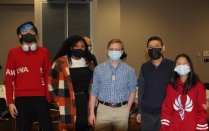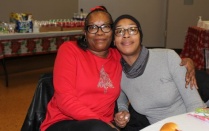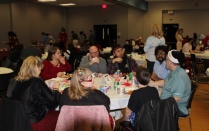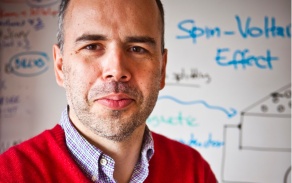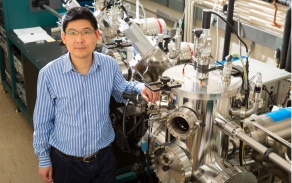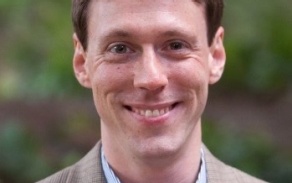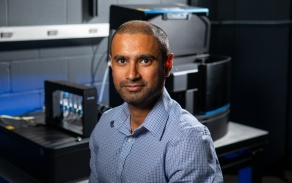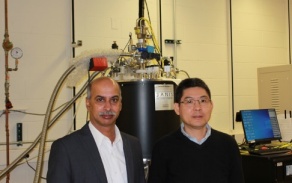

A silicon substrate with 2D heterostructures on top of a coin. Photo: Douglas Levere
In this Issue:
Support your Department
Dear alumni and friends,
I hope you had a healthy and successful year. It is that time of the year when I look forward to sharing some inspiring and wonderful stories of our students, alumni and faculty members. To start off, two of our undergraduate students, Paul Dewan Jr. and Krish Patel, are the recipients of the prestigious, nationally competitive Barry M. Goldwater scholarship 2022 for excellence in education. Professor Zutic and his post-doctoral fellow Dr. Xu mentored Krish Patel and Professor Banerjee mentored Paul Dewan Jr.
We are delighted to announce that Professor Hao Zeng received the UB Exceptional Scholar: Sustained Achievement Award 2022. In January, we welcomed Dr. Changjiang Liu (tenure-track Assistant Professor) and in August, we welcomed Dr. Herbert Fotso (tenure-track Associate Professor). Dr. Liu’s research interests are in experimental condensed matter physics in the field of synthesis of quantum materials (superconductivity, spintronics) and Dr. Fotso’s research interests are in theoretical/computational condensed matter physics (quantum information processing, correlated quantum systems). SUNY Distinguished Professor Eckhard Krotscheck retired earlier this year after a stellar research and teaching career spanning 50 years. We thank Eckhard for his contributions to the department and the physics community, please join me in wishing him all the best in retirement.
As many of you know, our department has long been known for students, staff and faculty with diverse ethnic, gender, racial identities and has been a welcome home for members from different cultures and nationalities. Hence it is not surprising that the physics community felt significantly troubled by recent worldwide events and the department has established an Equity, Diversity and Inclusion (EDI) committee last year. We have initiated activities during the Black History Month and also participated in the inaugural Visiting Future Faculty Program (VITAL), an exciting and rewarding four-day program that brings outstanding doctoral scholars from all disciplines to the University at Buffalo. Margaret Ikape, from the University of Toronto, visited the department as a VITAL scholar in April 2022. VITAL program seeks to contribute to the growth of faculty from traditionally underrepresented populations in the United States, particularly from Indigenous, African American/Black, and Hispanic/Latinx backgrounds. I am committed to continue our activities and that the department will continue to participate and contribute to the efforts at UB and wider community towards equity, diversity and inclusion.
In 2022, we were excited to resume both of our popular public lecture series (Ta-You Wu Memorial lecture and Rustgi Memorial lecture) after a two-year break. Nobel Laureate Professor Stanley Whittingham visited the department to present the seventh Ta-You Wu Memorial lecture on lithium batteries on April 29, 2022. The campus came alive to welcome the Nobel Laureate and enjoyed the personal interactions and his lecture. Professor Hideo Hosono (Tokyo Institute of Technology, Japan) presented the eighth Ta-You Wu Memorial lecture on October 14. Professor Hosono is a pioneer in developing transparent oxide semiconductors that are widely used in displays of televisions, mobile devices, etc.
We are grateful to Professor Emeritus Bruce D. McCombe who was instrumental in creating an endowed fund, the Jiping Cheng Graduate Student Achievement Award, in memory of our alumnus, Dr. Jiping Cheng (PhD ’89), to be used for the purpose of supporting graduate student in physics. We thank Dr. Cheng’s wife, Dr. Wang, and friends who generously donated towards this fund.
Post-pandemic, we strive to engage with our alumni in better ways than before: I visited Portland, OR in May to meet with our department alumni working in Intel Inc. and other high-tech industries in that region. During the Fall semester, we invited two of our alumni (Dr. Alex Kitt, Director of Data Science, EWI and Dr. Luke Lyle, Research Assistant Professor, Penn State) to present their research and work and to provide mentoring and networking opportunities for our current students. We take immense pride in the success and careers of our students and alumni. We would love to hear about your work and life and look forward to an opportunity to host you here in Buffalo!
Stay in touch, be safe, stay healthy and I am sure we will have more exciting stories to share in the future.
Best regards,
Sambandamurthy Ganapathy
Chair and Professor of Physics

Dative epitaxy
Prof. Hao Zeng and his former postdoc Dr. Mengying Bian are co-authors on a recent paper in Advanced Materials, which discusses a new technique to grow epitaxial thin films on a van der Waals template, taking advantage of a special type of chemical bond called dative bond formed at the interface.
By Hao Zeng, PhD and Mengying Bian, PhD
With just the right number and strength of chemical bonds, Goldilocks epitaxy allows high quality crystalline thin films to be grown on any substrate. Growing oriented thin films on a single crystal substrate called epitaxy is a ubiquitous technology in the semiconductor industry. Conventional epitaxial growth relies on strong covalent bonding between a thin film and a substrate to fix the crystalline orientation. The stringent lattice matching requirement means that only a limited number of materials can be epitaxially grown with adequate quality. Further, interfacial strain due to the lattice mismatch between the two materials inevitably leads to defect formation, degrading device performance. Van der Waals epitaxy developed in the 1980’s circumvents such problems. However, the weak interactions result in misorientations of the grown films. The discovery of a new regime of thin film epitaxy promises to address these limitations. In a recent paper (Advanced Materials, 34, 2200117, 2022), the Zeng group discussed a new technique to grow epitaxial thin films on a van der Waals template, taking advantage of a special type of chemical bond called dative bond formed at the interface. Dative bonds with the right number and strength fix the crystalline orientation without lattice matching, while still allow strain relaxation to minimize interfacial defects.
Dative epitaxy could be useful for the semiconductor industry, by enabling technologically important compound semiconductors be epitaxially grown on complementary metal-oxide-semiconductor (CMOS) compatible substrates without lattice matching constraints, and with crystal qualities rivaling or exceeding those using conventional epitaxial techniques. UB has filed a provisional patent application for dative epitaxy methods, and is looking to expand on this research through collaboration with industry and research partners. The work also provides opportunities to explore interesting fundamental physics originating from the moiré superlattices formed by two atomically thin layers with large lattice mismatch, grown by dative epitaxy.
The experimental work in Zeng’s lab was led by former postdoc Mengying Bian with participation from graduate student Chang Huai and undergraduate student Austin Marga. Austin won a prestigious National Science Foundation Graduate Research Fellowship and is now a graduate student at Northwestern University. Dr. Bian is now an associate professor at the Beijing University of Technology.
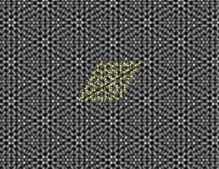
A beautiful moiré pattern formed from two atomically thin layers with a large difference in lattice spacings.
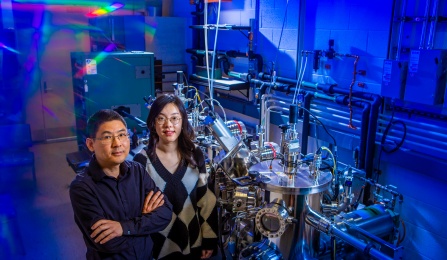
Prof. Hao Zeng (left) and Dr. Mengying Bian (right). Photo: Douglas Levere
By Salvatore Rappoccio, PhD and Ia Iashvili, PhD

Graduate Student Garvita Agarwal (shown here (second from right) in the CMS control room at CERN), a member of the UB CMS group, took part in the startup of the CERN Large Hadron Collider on July 5th, 2022, celebrating proton-proton collisions at an unprecedented high energy of 13.5 trillion electron volts.
The UB Compact Muon Solenoid (CMS) group has taken a very active role in the startup of the third Run of the Large Hadron Collider (LHC) in Geneva Switzerland. Graduate students Garvita Agarwal, Lauren Hay, Margaret (Meg) Morris, and AC Williams, as well as postdoctoral fellows Dr. Christine McLean and Dr. Juska Pekkanen and faculty Prof. Salvatore Rappoccio, have been stationed at the CMS experiment at the LHC during the startup phase. The rest of the team, including graduate students Hsin-Wei Hsia and Peter Young, postdoctoral fellow Dr. Duong Nguyen, and Profs. Ia Iashvili and Avto Kharchilava, have been actively participating in remote operations, data analysis, and detector commissioning from Buffalo. The new run of the LHC will reach a new center-of-mass energy of 13.6 trillion times the rest energy of the proton and is expected to collect 2x as much data as in the second run.
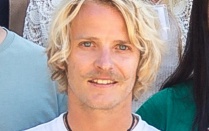
Dr. Pekkanen, postdoc in the UB CMS group, was selected as Distinguished Researcher (DR) for the year 2023 by the CMS LHC Physics Center (LPC) at Fermilab. The LPC serves as a primary resource and physics analysis hub for several hundred physicists at US institutions in the CMS collaboration. DRs serve as leaders who help LPC in its mission to operate as an educational and analysis center for US CMS via organizing workshops, tutorials, and forging close inter-group collaborations.
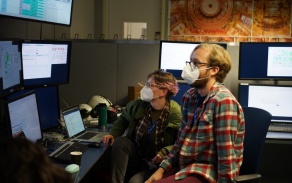
UB graduate student Lauren Hey (left) participated in the startup of Run 3 of the Large Hadron Collider (LHC) at the CMS detector in Summer 2022.
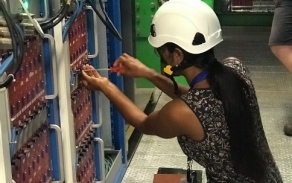
UB graduate student Garvita Agarwal working at CERN on the CMS detector.
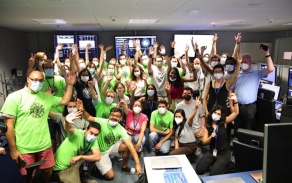
Prof. Rappoccio (far left) and graduate students Garvita Agarwal and Lauren Hey among CMS scientists celebrating the successful startup of the LHC in the CMS control room at CERN. Photo taken from CERN Accelerating science.
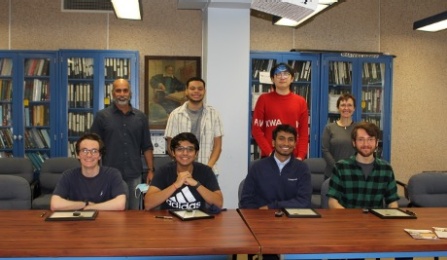
Sigma Pi Sigma 2020/2021 induction ceremony. Back row from left to right: Dr. Ganapathy, Paul Dewan Jr. (2020), and Xuanpu Zhang (2020), and Dr. Wackeroth. Front row from left to right: Kevin Smith (2020), Krish Patel (2021), Shahed Hanif (2021), and Luke Meiler (2020).
2020/2021 Sigma Pi Sigma honor society induction ceremony
By John Cerne, PhD
The Department of Physics inducted six undergraduate students into the Sigma Pi Sigma (SPS) honor society on December 3, 2021. The induction ceremony was officiated by Drs. Ganapathy and Wackeroth. Since the 2020 SPS induction ceremony was virtual, we were glad to be able to re-induct four of our honorees from that year in person. Our 2020 inductees are Paul Dewan Jr., Trevor Higgins, Luke Meiler, Kevin Smith, and Xuanpu Zhang. Our 2021 inductees are Shahed Hanif, Krish Patel, and Trey Wojnar. We congratulate our inductees for their great accomplishments and wish them all the best in their future endeavors!
UB undergraduate alumni return for seminars and meetings
By John Cerne, PhD
The Department is always happy to see our alumni return to UB, and this semester we were lucky to have our own former undergraduates, Dr. Alexander Kitt and Dr. Luke Lyle, go through a more intensive visit. In addition to giving seminars on their research and meeting with faculty, both Alex and Luke had separate meetings with our current undergraduate and graduate students. This is a lot more than we ask of our regular seminar speakers, so we really appreciated the time and effort that Alex and Luke spent on meeting with our students. Both had an evening meeting with our undergraduate students as well as a lunch meeting with our graduate students. Our undergraduate students were eager to learn about graduate school and careers after UB. Luke and Alex have travelled far in their careers since graduating from UB, but they connected strongly with our students. For example, it was amusing to hear them and our current students complain about the same math course at UB, which will not be named here!
Dr. Kitt graduated from UB in 2008 with a BS in Physics and a BA in Mathematics. He received a PhD in physics from Boston University in 2014, where he did optical and transport measurements on strained graphene. He also did extensive theoretical modeling of the strain-induced pseudovector potential in graphene. After Boston, Alex moved back to Western New York and worked as a post-doc at the University of Rochester Institute of Optics. He is currently the Director of Data Science at EWI in Buffalo, where he uses machine learning to analyze a wide range of manufacturing processes. He emphasized the importance of rigorous and fundamental training in computer programming to our students, especially since he had to learn a lot of it on his own. I now know what a unit test is! EWI is actively recruiting undergraduate and graduate students, and we are happy that he is providing them with new opportunities for internships and jobs at EWI.

Dr. Alexander Kitt meeting with undergraduate students during his visit.
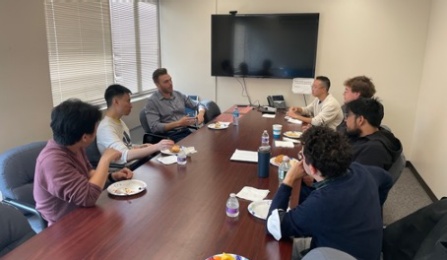
Prof. Luke Lyle at a lunch meeting with physics graduate students during his visit at UB.
Dr. Lyle graduated from UB in 2016, also with a BS in Physics and a BA in Mathematics. This seems to be a good combination of degrees! He got his PhD in Materials Science and Engineering from Carnegie Mellon University in 2020, where he worked on fabricating and characterizing metal contacts on wide bandgap semiconductors for high power applications. Luke is currently an Assistant Research Professor in the Electronic Materials and Devices Department at the Penn State Applied Research Laboratory. He is working on over a dozen projects there, including electronic materials growth, characterization, processing and device fabrication. He is busy supervising students and writing grant proposals. He had lots of good advice for our undergraduates on applying to graduate school and making career plans.
Both speakers impressed the faculty and students with their expertise and accomplishments after graduating from UB. I was fortunate to be able to attend the meetings with the undergraduate students. These were wonderful opportunities for our students to talk with graduates who traveled career paths that many of them are considering and to find out more about research and engineering. The undergraduate students had many questions and the discussions lasted over an hour at each meeting. We are very proud of Alex and Luke and appreciated them sharing their knowledge and experiences with us!

Prof. Whittingham at a meeting with Physics graduate and undergraduate students.

Prof. M. Stanley Whittingham, winner of the 2019 Nobel Prize in Chemistry, delivering the UB Department of Physics’ 7th Ta-You Wu Memorial Lecture.
The Seventh Ta-You Wu Memorial Lecture
By Peihong Zhang, PhD, Igor Zutic, PhD, and Murthy Ganapathy, PhD
After two years of disruption due to the pandemic, we restarted our annual Ta-You Wu Memorial Lecture this year. On April 29, 2022, Prof. M. Stanley Whittingham, winner of the 2019 Nobel Prize in Chemistry, delivered the UB Physics Department’s 7th Ta-You Wu Memorial Lecture titled “The Lithium Battery: From a Dream to Readiness to Take on Climate Change.”
Prof. Whittingham is SUNY Distinguished Professor of Chemistry and Materials Science and Engineering at Binghamton University. He shared 1/3 of the 2019 Nobel Chemistry Prize "for the development of lithium-ion batteries." The lecture attracted a large audience of about 200, including K-12 students from local schools.
Climate change is probably one of the greatest challenges of our time. Combating climate change would require a dramatic shift in our energy consumption from fossil fuels to carbon-free renewable energy, and battery technology plays a key role in future widespread adoption of renewable energy. Dr. Whittingham’s original research on the lithium battery not only enables mobile communication (e.g., cell phones) and computing (laptops), but may also become a critical component in tackling climate change.
In addition to the lecture, Dr. Whittingham met with our faculty and had a lunch conversation with Physics graduate and undergraduate students.
The Ta-You Wu Lecture Series was established through an endowment in remembrance of Wu, who served as a UB physics faculty member from 1966-78, and department chair from 1966-69. Distinguished scientists from all over the world have presented in the past editions of this public lecture. Born in China in 1907, Wu completed undergraduate study at Nankai University and received his PhD in 1933 from the University of Michigan. He was one of the leading atomic and nuclear physicists of his generation, with an international career spanning extraordinarily difficult times in Chinese and world history. He was a renowned educator who inspired generations of physics students. He also made significant contributions to the science and technology development in Taiwan. The endowment for the Wu lectureship was established by Y.C. Lee, a longtime colleague and close friend of Wu, and has received contributions from many donors.
The Eighth Ta-You Wu Memorial Lecture
By Hao Zeng, PhD
The Eighth Ta-You Wu Memorial Lecture was held on October 14, 2022. The lecture was given by Prof. Hideo Hosono from the Tokyo Institute of Technology. Prof. Hosono is an inventor of InGaZnOx thin-film transistors, which are now used as the backplane of large screen OLED-TVs. He is also widely known for his pioneering discovery of high Tc iron-based superconductors and room-temperature-stable electride materials with applications in catalysis. He has garnered numerous prestigious awards, among them the Japan Prize, the MRS von Hippel Prize, the APS J. McGroddy Prize, the Jan Raychman Prize from SID, the Imperial &Japan Academy Prize. He is a foreign fellow of the Royal Society and a Thomson Reuter Citation Laureate in physics (2013). In his Wu Lecture titled “Excitement in Materials Research: From material design to social implementation”, Prof. Hosono advised students to consider a career in materials research because it is a broad field full of opportunities and if successful, can generate huge societal impacts. During his visit at UB he also met with undergraduate and graduate students.
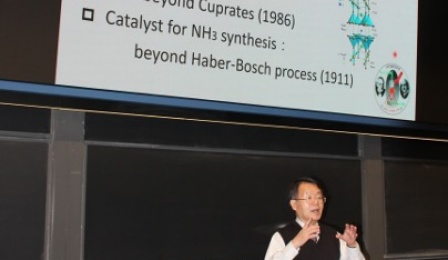
Prof. Hideo Hosono delivering the 8th Ta-You Wu Memorial Lecture in the Department of Physics at UB.
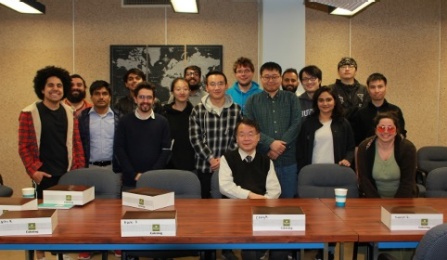
Prof. Hosono at a meeting with Physics students.

Among the awards handed out at the holiday party were the Om and Saraswati Bahethi Foundation PhD and MS scholarships. Shown here are the 2020-2021 MS scholarship recipients, Cameron Ballacchino (left) and Jinrui Bai (right). Congratulations!
2021 Holiday Party
By Nicole Pannullo
The Department of Physics celebrated the season on December 4, 2021, with our annual holiday gathering for all employees, students, and their families. The event was coordinated by Tracy Gasinski with assistance from Rachel Bolden and many student and faculty volunteers. The annual holiday party provides a time for our Physics community to come together with family to share a meal and live entertainment including a balloonist and caricature artist. The event also includes music, children’s gifts, favors, and door prizes.
The balloonist and caricature artists were kept busy at the holiday party.
Undergraduate students and Prof. Zeng with his daughter at the holiday party.
Rachel Bolden and her daughter LaMica S. Strong at the holiday party.
Tracy Gasinski with family and physics graduate students at the holiday party.
Team Building, Mentoring and Networking Hour
The kick off of the Department’s first team building, mentoring and networking hour after the pandemic took place on September 16 and will continue with two more events this semester. Many faculty and staff members joined and were happy to interact with our students, especially the ones who joined in the past 3 years and had limited personal interactions at UB due to the pandemic. The menu consisted of a Taco Bar (shells, beef, chicken, rice, black beans, cheese, vegetables, salsa, chips etc.), and desserts.
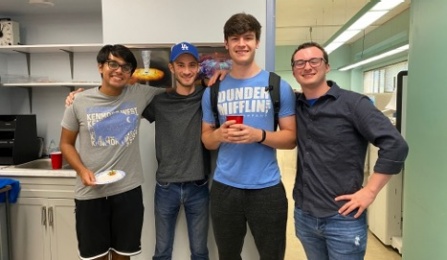

From left to right, Dr. Wackeroth, four prospective students, Paul Dewan, Keopasith Phaphanthong, Zaw Ko Oo, and Dr. Ganapathy.
Open House
By John Cerne, PhD
After a hiatus due to COVID-19, the Department hosted its first in-person Open House in three years on October 15, 2022. It was great to see visiting students and their families again! The Open House began with a talk by the CAS Dean Schulze, followed by an information session with our CAS Ambassadors, Paul Dewan and Zaw Oo Ko. Eight prospective students talked with Paul and Zaw. Then the four prospective undergraduate students and their families heard a welcome talk by the Physics Chair, Dr. Ganapathy. Dr. Ganapathy was joined by our Associate Chair, Dr. Wackeroth, in welcoming our visitors. The talk was followed by tours of three research labs in Fronczak. The tours were led by Paul, Zaw, and our Society of Physics Students President, Keopasith Phaphanthong. Haolei Hui presented work on multifunctional magnetic materials in Dr. Zeng’s lab, Nicholas Jerla and Priyanka Vadnere talked about metal-insulator transition research in Dr. Ganapathy’s lab, and Dr. Timothy Lafave discussed THz spectroscopy of proteins in Dr. Markelz’s lab. Many undergraduate students are involved in research in these and other physics labs at UB, so the prospective students were able to see how they could become involved in research. The Open House is a great way to recruit outstanding undergraduate students by showcasing the Department. We are grateful to our students and faculty who made this event possible.
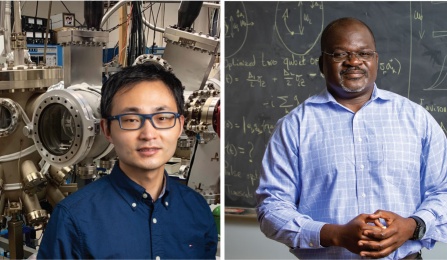
Changjiang Liu, PhD, Assistant Professor (left) and Herbert F. Fotso, PhD, Associate Professor (right).
Meet our New Faculty Members
The department is excited to introduce two new faculty members, Herbert F. Fotso, PhD, Associate Professor, and Changjiang Liu, PhD, Assistant Professor.
Changjiang Liu, PhD, joined the Department of Physics as Assistant Professor in the spring of 2022. He received his PhD in physics from the University of Minnesota, where he was focused on the study of spin transport in semiconductors. In his PhD thesis, he demonstrated how spin accumulations in semiconductors can be effectively detected using ferromagnetic resonance, which also allows for the measurement of short spin lifetimes below 100 picoseconds. Afterwards, he continued his research career as a postdoc at Argonne National Laboratory, where he used molecular beam epitaxy to grow quantum materials and investigated their emergent phenomena. He found that short-range magnetic ordering in frustrated magnetic systems can be detected using thermal excitations of magnons which is also known as the spin Seebeck effect. He observed signatures of antiferromagnetic quantum critical point in high-purity LaNiO3. He discovered two-dimensional superconductivity at interfaces of KTaO3 with other oxide insulators. The interfacial superconductivity of KTaO3 oxide system is tunable and with superconducting transition temperatures significantly higher than the existing oxide interfaces based on SrTiO3. He also demonstrated how magnon spin current can be electrically controlled in an antiferromagnet by using a magnetoelectric coupling. At UB, Dr. Liu will continue to use molecular beam epitaxy to synthesize quantum materials and investigate the charge/spin transport, magnetic, structural and optical properties of those materials. He anticipates that much more exciting physics can be uncovered in newly synthesized quantum materials.
Herbert F. Fotso, PhD, joined the Department of Physics as Associate Professor in the fall of 2022. He received his PhD in 2011 at Louisiana State University. In his thesis, he developed petascale numerical solutions for diagrammatic methods addressing strongly correlated quantum systems. After completing his thesis, he had postdoctoral fellowships at Georgetown University and at the Department of Energy (DOE) Ames Laboratory in Ames, Iowa. He was a faculty member with the Department of Physics at the University at Albany, SUNY from September 2016 until the summer of 2022. In his research, he studies the non-equilibrium dynamics of many-particle quantum systems with an emphasis on light-matter interactions that are relevant for Quantum Information Processing. He also studies the non-equilibrium dynamics of strongly correlated systems with the goal of understanding novel properties that arise away from equilibrium in these systems. These studies also aim to benchmark experimental efforts that study non-equilibrium processes in relevant materials both from the point of view of time-dependent spectroscopy experiments, and from the point of view of ultracold atomic gases in optical lattices to emulate various lattice models. In addition to applying a combination of analytical and computational approaches to problems across many subfields of Physics including AMO, Condensed Matter Physics, and Quantum Information Science, Herbert enjoys working with students and discussing science with broad audiences.
Faculty Awards
Professor Igor Žutić
Professor Igor Žutić, received a Multidisciplinary University Research Initiative (MURI) grant titled “Epitaxial Phase-Biased Josephson Junctions,” from the U.S. Office of Naval Research, which built on a previous collaboration with the experimental group of Professor Javad Shabani at the New York University. This team effort, led by Professor Shabani and also involving researchers from Yale University, the University of Maryland, the University of Pittsburgh, and the University of Illinois, Urbana-Champaign, will build on the discovery of topological superconductivity to provide a platform for manipulating elusive Majorana bound states, a key element for the fault-tolerant quantum computing.
In collaboration with the experimental group of Professor Cheng Gong at the University of Maryland, Professor Igor Zutic has received a grant titled “Ferroelectric Creation and Manipulation of Novel Topological States in 2D Heterostructures,” from U.S. Air Force Office of Scientific Research and an Early-Concept Grant for Exploratory Research (EAGER) titled “Cryo: Enabling efficient magnetocaloric refrigerants for <1 K cooling through magnetic quantum materials”, from the National Science Foundation, the Division of Materials Research. The research focus on both grants includes Zutic’s interest in transforming 2D materials by using various proximity effects.
Professor Sambandamurthy Ganapathy
Professor and Department Chair Sambandamurthy Ganapathy has been selected as a MAC Fellow 2022-2023 to participate in the 2022-2023 Mid-American Conference (MAC) Academic Leadership Development Program (ALDP). Up to four outstanding individuals are selected each year to serve as UB's MAC-ALDP Fellows under the mentorship of the Vice Provost for Faculty Affairs. This fellowship provides an opportunity for UB faculty to gain valuable knowledge and experience in academic leadership by working closely with select administrators from other colleges and universities in the MAC.
Professor Hao Zeng
Professor Hao Zeng has received the 2022 UB Exceptional Scholars: Sustained Achievement Award. Established in 2002, this award honors outstanding professional achievement that has been focused on a particular body of work over a number of years. This award was created to recognize an unprecedented accomplishment in a senior scholar's career, distinguishing a body of work of enduring importance that has gone beyond the norm in a particular field of study.
Professor Benedikt Harrer
Professor Benedikt Harrer (Co-PI) together with Virginia J. Flood (Assistant Professor of Learning Sciences, Graduate School of Education, PI) have received an award from the National Science Foundation (NSF) titled ”Dialogic gesture in collaborative sense making in physics” to investigate the role nonverbal communication plays in undergraduate physics students’ group problem solving success. The study will examine how students pay attention to, exchange, and interact with each other’s gestures as they make sense of physics problems together. This interdisciplinary project is funded through NSF’s Education and Human Resources Core Research program, which supports fundamental STEM education research.
Professor Priya Banerjee
Professor Priya Banerjee received a St. Jude Children’s Research Hospital Collaborative Grant on the Biophysics and Biology of Phase Transitions in Living Cells which started in March 2022. This 5-year grant will fund the joint research and administrative efforts amongst 6 collaborative members: Paul Taylor (HHMI/St Jude), Tanja Mittag (St Jude), Richard Kriwacki (St Jude), Rohit Pappu (Wash U at St Louis), Cliff Brangwynne (HHMI/Princeton), and Priya Banerjee (UB). In 2015, St. Jude Children’s Research Hospital launched Research Collaboratives as part of their strategic plan to bring together the world’s experts, regardless of where they work, to tackle some of the toughest questions pertaining to current human health and diseases. These projects are chosen based upon the potential to transform science and medicine. The research projects of this collaborative will leverage the collective expertise of its members in polymer physics, biophysics, soft matter physics, structural biology, molecular biology, and cell biology to further our understanding of disease mechanisms that arise from aberrant phase transitions in living systems.
Professors Sambandamurthy Ganapathy (left) and Hao Zeng (right)
Professor Sambandamurthy Ganapathy (left) and Prof. Hao Zeng (right) have received an award from the National Science Foundation - ECCS division, titled “Acquisition of Magneto-optical-high-frequency cryogen free probe station for research and education”. The PI is Prof. Uttam Singisetti (UB Department of Electrical Engineering (EE)) and fellow Co-PIs are Prof. P. Q. Liu (EE), and Prof. Q. Jia (UB Department of Materials Design and Innovation).
VITAL scholar Margaret Ikape visits the Physics department
By Murthy Ganapathy, PhD
Margaret Ikape, a PhD candidate in the Dunlap Department of Astronomy and Astrophysics, University of Toronto, visited UB and the Department of Physics as a member of UB’s inaugural class of 2022 VITAL scholars.
Margaret Ikape is a PhD candidate in the Dunlap Institute for Astronomy and Astrophysics, David A Dunlap Department of Astronomy and Astrophysics, University of Toronto. She was born in Nigeria, where she received her undergraduate degree in Physics and Astronomy. She completed a Masters degree in the African Institute for Mathematical Sciences, AIMS, Cameroon before beginning graduate studies in Toronto. Her interest in astronomy started at a very young age and that interest has been sustained by the numerous unknowns in the universe. Her current work tries to understand the nature of the first stars using simulated data. Ikape presented a department colloquium titled “Probing the Epoch of Reionization with the Simons Observatory” on March 31, 2022. UB’s inaugural class of 2022 VITAL scholars was featured in a UBNow article.
The Visiting Future Faculty Program (VITAL) is an exciting and rewarding four-day program that brings outstanding doctoral scholars from all disciplines to the University at Buffalo. VITAL seeks to contribute to the growth of faculty from traditionally underrepresented populations in the United States, particularly from Indigenous, African American/Black, and Hispanic/Latinx backgrounds. VITAL scholars have the opportunity to present their work, engage with UB faculty and students, meet other scholars in the program, and experience the region’s many offerings. Doctoral scholars in physics who are interested to be part of this program, please reach out to us!
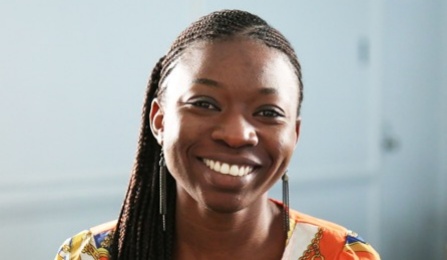
Margaret Ikape.
2022 Barry M. Goldwater Scholarship

Paul Dewan Jr. (left) and Krish Patel (right), both conducting research in the Department of Physics, won the 2022 Barry M. Goldwater Scholarship, a prestigious national honor. They are shown here with fellow recipient and Chemistry student Meghan Sullivan. Photo: Douglas Levere
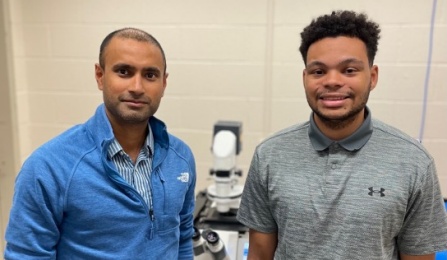
Paul with his research advisor Prof. Banerjee in the Banerjee Lab.
Paul Dewan Jr.
Paul started working in the Banerjee Lab in the Department of Physics at the beginning of his junior year. He was initially surveying labs focused on biophysical research across campus but was drawn towards joining this Lab by the intriguing idea of phase separation and membranelles organelles, previously unknown to him before joining. Upon joining the group, he was quickly exposed to the interdisciplinary work done in the lab and was afforded the opportunity to work with lab members across biology, physics, chemistry, and engineering to learn about how the group used cutting-edge quantitative methods to characterize phase separation of biomolecules. As he began to become more comfortable in the group, he started to apply for the Goldwater Scholarship under Dr. Banerjee’s mentorship. Through his experiences performing experiments and learning to think about scientific discovery under the guidance of Dr. Banerjee and other lab members of the Banerjee Lab, he was able to write a more competitive application and gain valuable skills for his future career. After graduation, Paul will pursue a Ph.D. degree in biophysics with the hope of being able to elucidate physical mechanisms that govern the complexity of living systems. He hopes to be able to continue performing research in this exciting new field at the intersection of biology and physics with the skills he has developed at the University at Buffalo.
NSF Graduate Research Fellowship
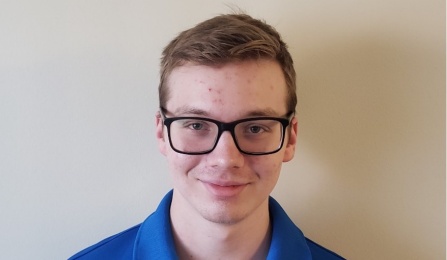
Austin Marga won a prestigious NSF Graduate Research Fellowship in April 2022 when he was a physics senior. Austin worked in Prof. Hao Zeng’s research group at UB since October 2020 and is a co-author in two recent, high impact publications. He is now a graduate student at Northwestern University.
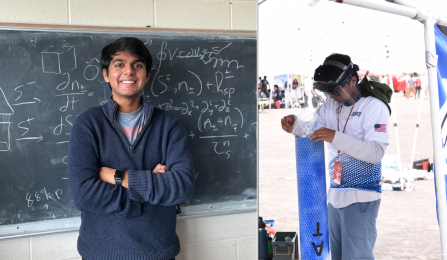
Left: Krish, at the Zutic Lab Graduate Office, partially blocking the equations for spin-lasers. Right: In a UB SEDS Rocketry uniform, as the Project Director of the team, at the 2022 Intercollegiate Rocket Engineering Competition. He is the lead of the technical sections in charge of designing, simulating and testing the rocket and parachute system.
Krish Patel
Krish who was still a sophomore when he received the award, had an early start in research. Already in high-school, Krish has expressed his interest to explore research in theoretical condensed-matter physics and has joined the group of Prof. Igor Zutic in the Department of Physics, where he worked closely with former UB PhD student Gaofeng Xu on spin-lasers. With his research progress and outstanding academic record, Krish had many options for pursuing his studies in physics, but with UB’s strong recruitment effort to keep him at Buffalo and the award of the Presidential Fellowship, the choice for him was easy. With the start of the Covid-19 pandemic, Krish has continued to work diligently and adjust to the online communications, which were often set late at night to accommodate the time-difference with Gaofeng in China, who has since graduated and taken position of an Associate Professor at the Hangzhou Dianzi University.
At the core of Krish’s research is the modeling of spin-dependent phenomena in semiconductor lasers. Unlike in conventional lasers, where the equal number of spin up and down carriers renders spin irrelevant, he has found important changes in scaled-down lasers where this spin balance is disturbed and the emitted light is circularly polarized. Since it was experimentally demonstrated in collaboration between researchers in Germany led by Prof. Nils Gerhardt at Ruhr University at Bochum and UB [Nature 568, 212 (2019)] that spin-lasers can operate an order of magnitude faster than the best conventional lasers and with a much lower energy consumption, the prospect of scaling down such spin-lasers offers fascinating opportunities. Krish’s work, Appl. Phys. Lett. Appl. Phys. Lett. 119, 171104 (2021), chosen as the Editors Pick, already reveals subtleties in their nonlinear response, which is important to understand as such lasers could be a platform for an efficient data transfer, one of they key challenges for the explosive growth of information and communication technology. By 2030, large data centers alone are predicted to require 8% of the global electricity use. As a part of his proposed research for the Goldwater, Krish has recognized that the same properties of spin-lasers that allow their ultrafast switching of the polarization of the emitted light can also further push the limits of brain-inspired computing. Artificial neural networks with spiking neurons based on spin-lasers, may offer important advantages with much higher switching speeds and larger bandwidths, compared to both biological neurons and their electronic counterparts. Prof. Gerhardt and other researchers in spin-lasers are keeping their eyes on Krish’s findings. Just like spin-lasers, his future is bright.
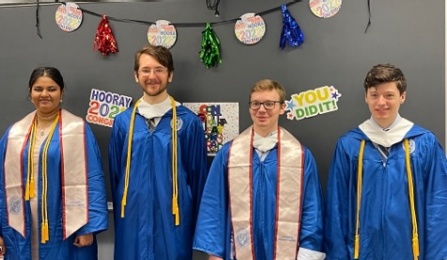
Some of our graduating seniors at the Department reception after the commencement ceremony. From left to right are: Tanmayee Gujar, Luke Meiler, Austin Marga, and David Andrzejewski.
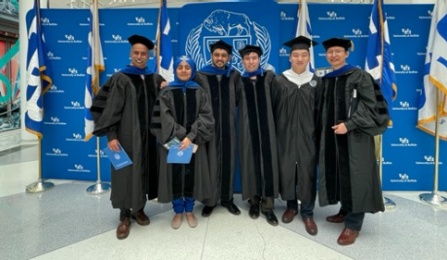
Some of our graduating Master and PhD students after the ceremony. From left to right: Dr. Ganapathy, Taranpreet Kaur, PhD, Arinjoy Bhattacharya, PhD, Jiawei Wang, PhD, Junghwan Yim (MS/BS combined), and Dr. Hu.
Graduate Student Awards
Gasparini Thesis Prize (2022)
- Garvita Agarwal
- Ibraheem Alshareedah
- Rance Solomon
- Zhao Tang
Outstanding Teaching Assistants (2021-2022)
- Hirak Bandyopadhyay
- Nina Stein
- Piaohon Xu
Om and Saraswati Bahethi Scholarship (2022-2023)
PhD
- Greis Cruz Reyes
- Samuel Powers
- Lauren Hay
MS
- Shreekanth Yuvarajan
Undergraduate Awards (2021-2022)
CAS College Ambassadors
- Paul Dewan
- Zaw Oo Ko
Outstanding Seniors
- Austin Marga
- Luke Meiler
Sekula Scholarship
- Mars Andersen
- Shiyuan (Sean) Ge
- Trevor Higgins
- Tom McEntire
Recent Graduates
Fall 2021
PHYSICS PHD
Taranpreet Kaur
Advisor: Priya Banerjee
Thesis Title: “Unravelling the Phase behavior and Condensate properties of Multicomponent Protein-RNA Mixtures”
Jiawei Wang
Advisor: Eckhard Krotscheck
Thesis Title: “Many-body correlations in neutron star matter”
PHYSICS BACHELOR’S
- Andrew Buchwald
- Paul Pullara
Spring 2022
PHYSICS PHD
Ibraheem Alshareedah
Advisor: Priya Banerjee
Thesis Title: "Reentrant Phase Transitions in Protein-Nucleic Acid Mixtures"
Arinjoy Bhattacharya
Advisor: Athos Petrou
Thesis Title: "Injection of spin polarized electrons into CdSe/CdZnS core-shell nanoplatelets"
Akansha Sharma
Advisor: Andrea Markelz
Thesis Title: “Observation of Photoswitching of Picosecond Protein Dynamics Using Terahertz Dynamical Transition Measurements”
PHYSICS MASTER'S
- Alexander Bivolcic
PHYSICS BACHELOR’S
- David Andrzejewski
- Kenneth Escobar
- Tanmayee Gujar
- Jon Kick Jr.
- Austin Marga
- Luke Meiler
- Omar Radwan
- Bartlomiej Skica
- Randy Soldevilla
- Robert Thompson
- Matthew Weinberg
- Junghwan Yim
Summer 2022
PHYSICS PHD
Huanfeng Cheng
Advisor: Doreen Wackeroth
Thesis Title: "Improved Predictions for Triple Electroweak Gauge Boson Production at the Large Hadron Collider”
Ishiaka Mansaray
Advisor: Jong Han
Thesis Title: "Non-equilibrium phonons in graphene and moire-gapped graphene under high electric fields"
Zhao Tang
Advisor: Peihong Zhang
Thesis Title: “Electronic and optical properties of 2D materials from first principles
PHYSICS MASTER'S
- Jeffrey Carvalho
PHYSICS BACHELOR’S
- Sergio Hernandez
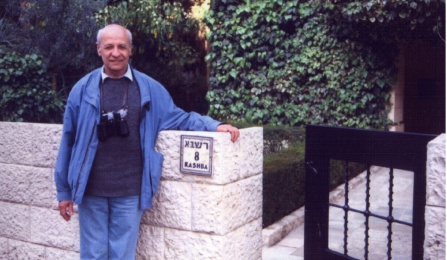
Former UB Department of Physics Research Professor, Emmanuel I. Rashba, in front of his house in Jerusalem. Photo credit: AIP Emilio Segrè Visual Archives, Rashba Collection.
Former Research Professor wins 2022 Oliver E. Buckley Prize of the American Physical Society (APS)
By Bruce D. McCombe, PhD
Gene Dresselhaus and Emmanuel I. Rashba shared the 2022 Oliver E. Buckley Prize of the APS in Condensed Matter Physics “For pioneering research on spin-orbit coupling in crystals, particularly the foundational discovery of chiral spin-orbit interactions, which continue to enable new developments in spin transport and topological materials.”
This prestigious prize is awarded annually “to recognize and encourage outstanding theoretical or experimental contributions to condensed matter physics.”
The co-recipients’ early work concerned the effects of spin-orbit interaction on the band structure near the Brillouin Zone center of zinc blende and wurtzite semiconductors, whose crystal lattices lack inversion symmetry. Their results guided our understanding of anisotropies in important electronic quantities in the otherwise nearly spherically symmetric conduction band of these semiconductor crystals. More recently, their results have been employed in schemes to manipulate and control electron spins. Bychkov and Rashba showed that Rashba’s early results could be taken over to quasi-two-dimensional carriers in materials that possess inversion symmetry with an asymmetry introduced by external means. This led to a variety of potential applications of different materials and structures, the iconic application being the spin transistor. Many approaches for spintronics or quantum information technologies have made use of these results for device structures that control spins via electric fields. The importance of this work has been tremendous, not only as the seminal work in the whole field of spin-orbit effects in semiconductors, but also in stimulating new physics and applications. It is still having important impact in spintronics, nanostructures and quantum computing, as well as in several emerging areas of research and applications, e.g., topological insulators, graphene, and Majorana fermions.
Interestingly (especially to me), Rashba’s theoretical work had a strong effect on my career. Two colleagues and I were inspired by Rashba’s early papers to investigate the predicted combined (cyclotron plus spin)-resonance in n-type InSb. We published initial results in 1967, and I met Rashba at the 1968 International Conference on the Physics of Semiconductors in Moscow. He was pleased that we had been able to observe the combined resonance (communication was slower in those days.), and he encouraged me to continue our work. We met again at the joint US-Soviet Symposium in Moscow in 1988, during which the US delegation visited Chernogolovka (the first time for US scientists). We did not meet again until after he had moved to the University of Utah and had survived a serious illness. At that time, when the “spintronics” effort was flowering, a group of us wrote a successful consortium proposal to DARPA. We appointed Rashba to a Research Professorship in Physics. He was a great collaborator, very generous and helpful to me and other colleagues and to several of our students. He was a delightful presence in the Department of Physics when he visited. He gladly spoke with students, as well as with his collaborators on the faculty, on those occasions. All of us benefitted greatly from his contact and interactions.

Alumni Michael Morse (left) and Benjamin Cammett (right) at the 2022 Berlin Marathon in Germany.
Personal Bests in Berlin
UB Department of Physics Alumni Michael Morse (PhD 2020) and Benjamin Cammett (MS 2019) at the 2022 Berlin Marathon in Germany. They both set new personal bests, with Ben and Michael beating their old records by about 10 minutes and 30 minutes, respectively. After Berlin, they were heading to Munich for Oktoberfest.
Thank you for your support of the Department of Physics. With the support of alumni and friends, we can provide vital resources to enhance our department and provide support for students, research projects and programs. We are grateful for your generosity.
You can support your department and help to provide for our students by making a gift online.

